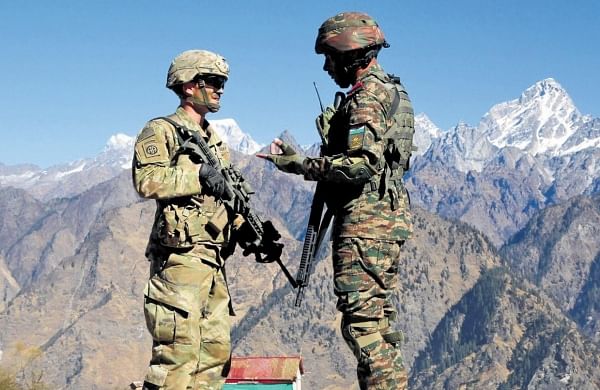Express News Service
NEW DELHI: Using the powers under the Emergency Procurement, India has filled up critical capability voids.
The sources in defence establishments confirmed that the primary objective of EP was to plug critical operational gaps, especially along the Northern Borders.
The EP has been instrumental in capital procurement through approximately 140 schemes, spread across four tranches (EP I to IV). The initial three tranches witnessed the Indian Army utilizing approximately Rupees 6500 crore, finalizing 68 contracts, sources said.
The last phase of procurement under EP-IV alone, which spanned from September 2022 to September 2023, facilitated more than 70 schemes worth nearly 11,000 crores.
Elaborating on major upgrades facilitated through the EP mechanism “encompassed Remote Control Weapon systems, Air Defence missiles, Anti Tank Missiles, Satellite Downlink & Recording systems, VSAT terminal, Portable mobile terminals, Secure Army Mobile systems, All Terrain Vehicles, High Mobility Reconnaissance Vehicles, Radars, Loiter Ammunition, Drones, Counter Drone systems, High Endurance Unmanned Aerial Vehicles (UAVs), Ballistic Helmets, Navigation Systems, and Simulation systems.”
Schemes Under Phase IV:
6-7 schemes costing around Rs 1300 crores for Weapon systems.
7-8 Projects costing Rs 1300 crore for protective equipment.
9 to 10 schemes allocated almost Rs 1500 crore for Intelligence, Reconnaissance, and Surveillance.
About 10 projects of Rs 2000 crore were reserved for Drones and counter drones.
More than 12 projects costing approx Rs 1800 cr for Communication and non-communication equipment.
About 25 projects of Rs 3100 crore were used for about 25 projects on Survivability and Training.
Attributing to India’s rapidly evolving security landscape in recent times, “the need to address critical operational requirements has never been more pressing.”
“To address these urgent needs, the government wisely implemented an Emergency Procurement (EP) mechanism, expediting the acquisition of vital equipment and technology for the defense forces.,” said sources.
This scheme, said the sources, is helpful in promoting Indigenous Industries
“A salient feature of the EP mechanism is its emphasis on ‘Atmanirbharta’ or self-reliance. A remarkable 50% of contracts in the first three tranches were awarded to the domestic industry. EP-IV has concluded more than 70 schemes, amounting to close to Rs 11,000 Cr, all of which are contracted with Indian vendors.” Sources said.
As per the sources, the EP mechanism isn’t just about swift procurements; it’s also about economic intelligence. “The first three tranches of EP realized savings of around Rs 550 crore. The fourth phase itself led to savings of approximately Rs 1500 crore.”
While the EP initiative has been pivotal in addressing immediate operational requirements, sources pointed out, it’s evident that such a mechanism needs to be institutionalized for the long term.
NEW DELHI: Using the powers under the Emergency Procurement, India has filled up critical capability voids.
The sources in defence establishments confirmed that the primary objective of EP was to plug critical operational gaps, especially along the Northern Borders.
The EP has been instrumental in capital procurement through approximately 140 schemes, spread across four tranches (EP I to IV). The initial three tranches witnessed the Indian Army utilizing approximately Rupees 6500 crore, finalizing 68 contracts, sources said.googletag.cmd.push(function() {googletag.display(‘div-gpt-ad-8052921-2’); });
The last phase of procurement under EP-IV alone, which spanned from September 2022 to September 2023, facilitated more than 70 schemes worth nearly 11,000 crores.
Elaborating on major upgrades facilitated through the EP mechanism “encompassed Remote Control Weapon systems, Air Defence missiles, Anti Tank Missiles, Satellite Downlink & Recording systems, VSAT terminal, Portable mobile terminals, Secure Army Mobile systems, All Terrain Vehicles, High Mobility Reconnaissance Vehicles, Radars, Loiter Ammunition, Drones, Counter Drone systems, High Endurance Unmanned Aerial Vehicles (UAVs), Ballistic Helmets, Navigation Systems, and Simulation systems.”
Schemes Under Phase IV:
6-7 schemes costing around Rs 1300 crores for Weapon systems.
7-8 Projects costing Rs 1300 crore for protective equipment.
9 to 10 schemes allocated almost Rs 1500 crore for Intelligence, Reconnaissance, and Surveillance.
About 10 projects of Rs 2000 crore were reserved for Drones and counter drones.
More than 12 projects costing approx Rs 1800 cr for Communication and non-communication equipment.
About 25 projects of Rs 3100 crore were used for about 25 projects on Survivability and Training.
Attributing to India’s rapidly evolving security landscape in recent times, “the need to address critical operational requirements has never been more pressing.”
“To address these urgent needs, the government wisely implemented an Emergency Procurement (EP) mechanism, expediting the acquisition of vital equipment and technology for the defense forces.,” said sources.
This scheme, said the sources, is helpful in promoting Indigenous Industries
“A salient feature of the EP mechanism is its emphasis on ‘Atmanirbharta’ or self-reliance. A remarkable 50% of contracts in the first three tranches were awarded to the domestic industry. EP-IV has concluded more than 70 schemes, amounting to close to Rs 11,000 Cr, all of which are contracted with Indian vendors.” Sources said.
As per the sources, the EP mechanism isn’t just about swift procurements; it’s also about economic intelligence. “The first three tranches of EP realized savings of around Rs 550 crore. The fourth phase itself led to savings of approximately Rs 1500 crore.”
While the EP initiative has been pivotal in addressing immediate operational requirements, sources pointed out, it’s evident that such a mechanism needs to be institutionalized for the long term.




